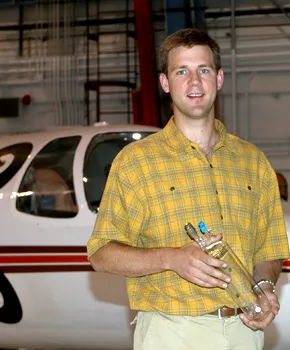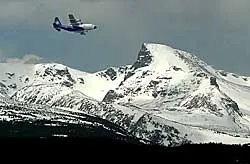Britton Stephens - Scientist
Shedding light on the carbon cycle and other Earth science questions

Britt Stephens
Photo by Carlye Calvin, UCAR
Britt Stephens became fascinated with Earth sciences during high school field trips in northeastern Oregon where he grew up. When he started college at Harvard University, he was determined to branch out into new subjects. But he really enjoyed a class on our planet's history taught by Stephen J. Gould, the influential paleontologist and evolutionary biologist.
He also enjoyed spending time with his grandfather, an outdoorsman with stories about the wilderness that no longer exists in New England. "The stories made me think about how much things had changed, and will change in my lifetime," Britt says. "I decided it was okay to study Earth sciences."
After graduating with a major in Earth and planetary sciences, Britt went on to earn a doctorate in oceanography from the Scripps Institution of Oceanography at the University of California, San Diego. Today, he works as a scientist in NCAR's Earth Observing Laboratory, where his job satisfies both his intellectual curiosity and love of the natural world.
Britt focuses on building new instruments and adapting existing ones that he and other scientists can use to study the global carbon cycle. The carbon cycle is the continual movement of carbon atoms through living organisms, the oceans, atmosphere, and crust of the planet. The cycle is especially critical because when we burn fossil fuels such as coal and oil, we release carbon into the air, where it acts as a greenhouse gas and traps heat in the atmosphere.
Britt's instruments and research are important for climate change because they shed light on how Earth's biogeochemical systems—the interplay among the atmosphere, plants, and oceans—are responding to the build-up of carbon in the atmosphere. "We're dumping all this carbon dioxide in the atmosphere, and to predict what is going to happen we need to have a good understanding of how natural systems work," he says.
He also hopes to help find practical solutions to mitigate future climate change. "There's a lot of work to be done in coming up with ideas for getting carbon dioxide out of the atmosphere, as well as assessing ideas already out there."

Composite of the NSF/NCAR C-130 research aircraft flying over the Rocky Mountains in Boulder.
Photo by Carlye Calvin, UCAR
One of Britt's most recent projects was the Airborne Carbon in the Mountains Experiment, in which he and colleagues flew over the Rocky Mountains just west of Boulder aboard the NSF/NCAR C-130 research aircraft to measure how much carbon dioxide mountain forests remove from the air. The team combined airborne data with ground-based measurements to get a more accurate picture of carbon exchanges in rolling hills and mountain ranges. As a broader part of the project, Britt also developed a new tower-based carbon dioxide analysis system that is less expensive and easier to maintain than older systems. He is collaborating with several universities to deploy similar instruments at research sites around the country.
Some of Britt's other projects include maintaining field instruments, developing calibration systems for gas measurements, and pulling together data on atmospheric carbon dioxide from around the world to compare with computer models.
"I've always been interested in a lot of different things and try to move on as many different fronts as possible," he says. "My desk often has twenty different stacks of paper, each one corresponding to a different project."
Britt's favorite thing about his job is that it allows him to apply creativity to complex problem solving. "Trying to answer questions that no one has yet been able to answer appeals to me," he says. "The way I stay motivated is by pursuing new ideas."

Britt at Niwot Ridge
Photo by Carlye Calvin, UCAR
"And I like the idea that what I'm doing might make the world a better place," he adds.
Not surprisingly, another thing Britt likes about his job is that it requires a lot of outdoor fieldwork, usually reached by foot, plane, or ship. He has sailed to the middle of the Pacific to service scientific buoys and measure oxygen and carbon dioxide in the atmosphere. He has made the voyage from Chile to the Antarctic Peninsula and back, spent time hiking through forests in New England, and traversed the Juneau Icefield in Alaska and British Columbia, all in the name of research. Britt's work often takes him to Niwot Ridge in the mountains near Nederland, Colorado, where NCAR and other institutions maintain a field site in the National Science Foundation's Long-Term Ecological Research Network.
In the future, Britt hopes to see the instruments he has developed increasingly used to address scientific questions. This might include deploying his oxygen instrument in airborne research missions and setting up carbon dioxide analyzers around the country to get a more accurate measurement of carbon emissions. He'd like to spend more time studying the Southern Ocean because it has a major effect on the atmosphere's carbon balance. He also wants to work on strategies for preventing carbon from building up in the atmosphere. Says Britt, "I really look forward to striving to answer these questions."
by Nicole Gordon
November 2004